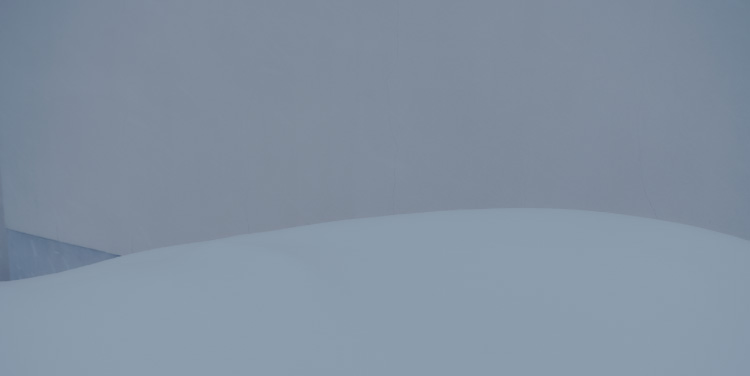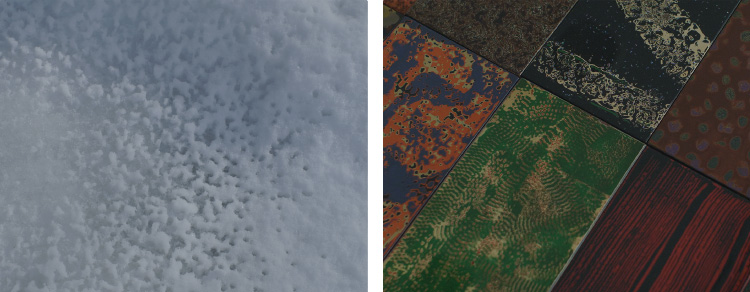

Up close it is hard to see. From afar, however, the appeal is obvious.
People in Snow Country truly face hardships from the snow. People say that the snow serves no purpose, and it would be good if it quickly went away. Snow causes work delays, makes it difficult to get around, and takes precious time out of the day in the pointless act of shoveling it. If you live in Snow Country, you surely know this painful reality.
On the other hand, people who come from far away and do not know the daily struggles that come with heavy snow are entranced by the beauty of Snow Country. Each time they take a step outside, they are struck by the landscape. The soft, smooth blanket of snow covering the ground. The pale bluish shadows created by gentle mounds of snow. A snowflake alighting on a deep black coat. A small hole formed by the drip of melted snow or ice. Even the snow mottled with dirt and pushed to the side of the road holds a certain charm.
The appeal that is difficult to see up close creates childlike excitement in people who come from far away. Keeping this frame of reference, let us turn to the handiwork born from this land to gain some new insights.
The appeal of crafts from the Tsugaru region can be more deeply understood if you come here during snow season. Back before there were cars and snowplows, you could not go anywhere once the snow started falling. It was a hibernation of a sort. While shut indoors, it was handiwork that made the time a joy and not a curse. People would settle down to do slow and careful work—work that takes time and patience to finish. The more time it took, the more elaborate the final product and the greater joy and meaning it brought.


The type of sashiko embroidery called koginzashi is one handicraft that developed from having time. Each stab of the needle is like a record of time existing in the cloth. The only time when busy farmwomen could sit down and still take credit for working was when they were embroidering by the fireplace. This time was savored, and simultaneously it was work that showed their love for their family.
Tsugaru-nuri is a style of lacquer ware that has been practiced in this region for centuries. Standard lacquer ware uses only red or black lacquer, or has pictures painted on the surface. Tsugaru-nuri, however, uses time to create a pattern. Speckles are painted on the foundation in color lacquer using a cloth or a spatula with holes in it. The lacquer is applied in many layers to create an effect reminiscent of mille-fueille. When the lacquer layers are finished, the surface of the piece is uneven and looks similar to snow blanketing hidden objects. But the piece is not yet finished. The real work is only just beginning. The layers of carefully applied lacquer are now polished with sandpaper and ground away to create a naturally rippled pattern on the surface. The many layers of color lacquer do not create a uniform pattern. Instead, the pattern shifts depending on how much lacquer is ground away and when the artisan decides to stop. After completing approximately 50 processes over a period of nearly two months, close to two-thirds of the lacquer is then polished off. This is also handiwork born of the blessings of time in Snow Country.
The geometrical patterns of kogin embroidery resemble falling snowflakes, and the speckled patterns of Tsugaru-nuri resemble the mixture of ice and dirt on a snowy road. The patterns in these crafts are strikingly similar to the natural beauty created by the snow.
Beauty that is taken for granted and unconsciously overlooked hides in craftwork. The things people see every day have a way of finding their way into the things they make. When spring comes, the snow melts into precious water that irrigates the land of Tsugaru. The snow, and the time that it brings, also becomes a rich blessing in the palm of the hand as well.
職種:店舗販売 / 営業 / 生産管理 / パタンナー / デザイナー
正社員登用、給与は経験により相談。月20万円以上。
年齢性別不問。
厚生年金、健康保険、雇用保険等完備。交通費支給、賞与。
ご希望の方は、メールにて履歴書と職務経歴書をお送り下さい。
通過者のみ面接の返信をいたします。なお募集の職種は時期によって異なる場合があるのでお問い合わせください。
*学生のインターンは随時可能ですので、希望者は面接いたします。
送信先メールアドレス:matohu@lewsten.com
◇ matohuの理念
「日本の美意識が通底する新しい服の創造」をコンセプトに文化や歴史を大切にしながら、現代人の心に響く魅力ある「デザイン」を生み出すこと。それを深い「言葉」で表現し、共感者の輪を拡げて行く「場」を作って行くこと。
この3つを通して、多様で心豊かな世界をともに作り上げることがmatohuのプロジェクトであり、理念です。
◇ 仕事のやりがいと人間的成長
まかされた仕事を自分の創意で工夫していける環境です。1Fはショップ、2Fはアトリエになっており、デザイナーと直接話しながらアイデアを実現していけます。また文化、歴史など幅広い知識を学ぶ機会も多く大人の教養と礼儀が身につき、人間的にも成長できます。
人の心に彩りを添えるデザインを生活のなかに!を合い言葉にこれから世界に向けて発信するmatohuのスタッフを募集します。